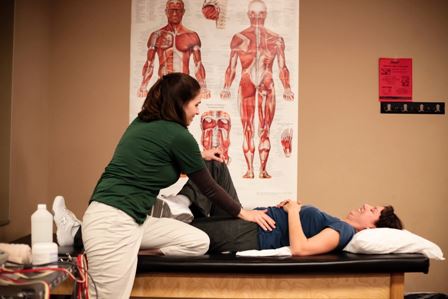Pelvic pain is a symptom that is easy to ignore. When considering talking to a doctor or physical therapist, women (and men) think about the awkward conversations, and the prospect of an invasive examination, and they often decide to postpone such uncomfortable situations.
But like any bodily pain, the longer it continues, the more likely that chronic pain is a sign that something is wrong and needs to be treated.

Pain that continues for six or more months would be considered chronic and worthy of discussion with a healthcare professional, according to the Academy of Pelvic Health Physical Therapy, a subset of the American Physical Therapy Association that offers training for physical therapists who want to specialize in women’s health or pelvic pain. Pelvic pain can present in the lower abdomen, pelvic or perineum, the Academy notes, and it could also feel like aching or burning.
Physical therapy can help with a variety of pelvic issues, notes Jessica Hice, a physical therapist at TOP Rehab, a Physiquality member in Tennessee. Jessica recently completed training about treating dysfunctions of the pelvis, including pelvic pain, as well as bladder, bowel and sexual health. This can include incontinence, pelvic weakness, limited tolerance for sitting, and pain during sexual intercourse.

Harvard Medical School recently noted the difficulty of proper diagnosis when it comes to pelvic pain. Women in particular would expect to discuss this with their gynecologist during an annual exam, but the article points out that gynecologists are trained to evaluate the sexual organs, not necessarily the muscles surrounding them. This is why physical therapists, who are experts in musculoskeletal health, are an excellent resource when dealing with pelvic pain, particularly if they have completed additional training. If you’re unsure what to ask or mention, the Academy has posted sample talking points for you to discuss with your doctor or physical therapist.
Any patient preparing for pelvic physical therapy should be aware that appointments may include an internal exam, as well as an external exam. Jessica says that PTs treating pelvic pain should explain each step of the evaluation and treatment, making sure that the patient thoroughly understands each step of the process and is prepared for such treatment. After the initial evaluation, Jessica notes that treatment can include patient education, manual therapies, therapeutic exercises (in the clinic as well as at home), functional re-training, behavioral strategies and modalities.

If you are seeking treatment for pelvic pain, be sure that your physical therapist has completed additional training specifically to work in this area. Jessica completed her coursework through the Herman and Wallace Pelvic Rehabilitation Institute, a group founded specifically to educate healthcare professionals about pelvic pain and treatment. And the Academy of Pelvic Health Physical Therapy offers not just coursework on pelvic pain, but two different certifications that require residencies or proof of thousands of hours of related patient care, as well as specific coursework and a thorough exam. These specialists often use initials after their credentials to denote what type of certification they have completed: WCS, which covers a variety of women’s health issues, and two types of CAPP (Certificate of Achievement in Pelvic Health Physical Therapy) certifications, one in general pelvic health and another in pre- and post-natal care.
Regardless of how you find your physical therapist, make sure that you are well informed about your PT, their training and their treatment. The more you understand about your condition and treatment, the more comfortable you will be during your appointments. Use our locator below to find a qualified Physiquality physical therapist near you.
Thank you to our contributors:

Jessica Hice, PT, DPT is a physical therapist and pelvic therapy specialist at TOP Rehab Services, Inc., a Physiquality member with two locations in Tennessee. She has been practicing physical therapy since 2015 and recently completed more than 20 hours of education in pelvic floor function, dysfunction and treatment. She is looking forward to further aiding the community treating the needs of individuals with pelvic floor dysfunction.
Pelvic physical therapy: Another potential treatment option. Harvard Medical School, June 2018.
The Academy of Pelvic Health Physical Therapy, American Physical Therapy Association.
- Pelvic physical therapy: The reality behind a curtain.
- Pelvic pain.
- Questions to ask your PT.
- Talking about your condition.
Herman and Wallace Pelvic Rehabilitation Institute.
- About pelvic rehabilitation. PelvicRehab.com.
- Mission. HermanWallace.com.
“Deadly Listeria Food Poisoning: Who are at Risk?” by jpalinsad360 is licensed under CC BY-SA 2.0.